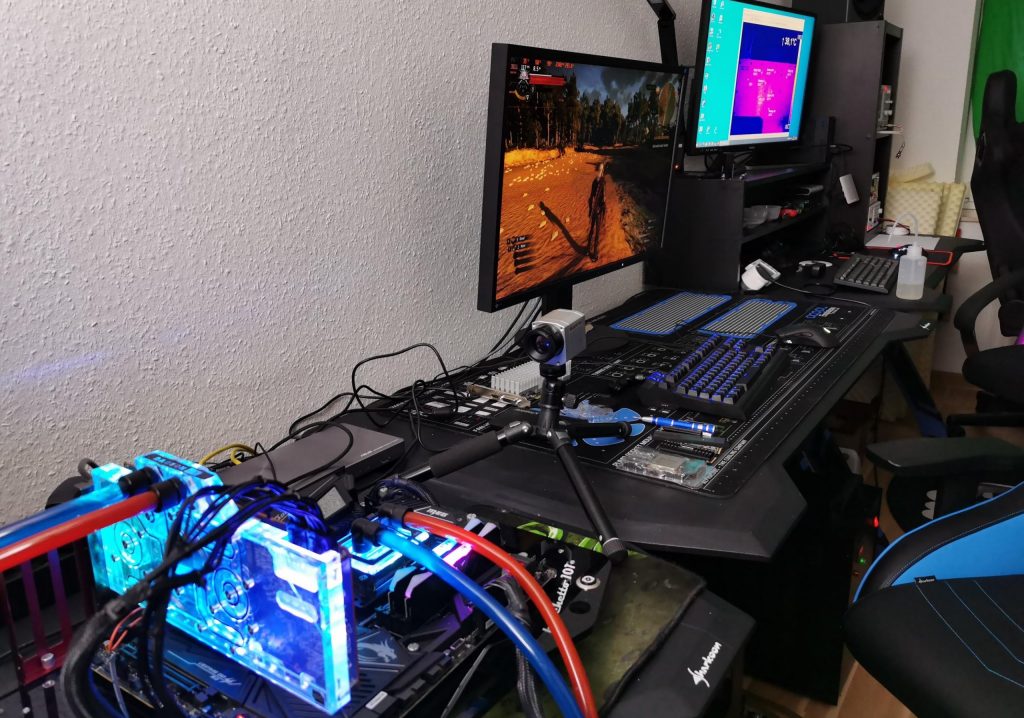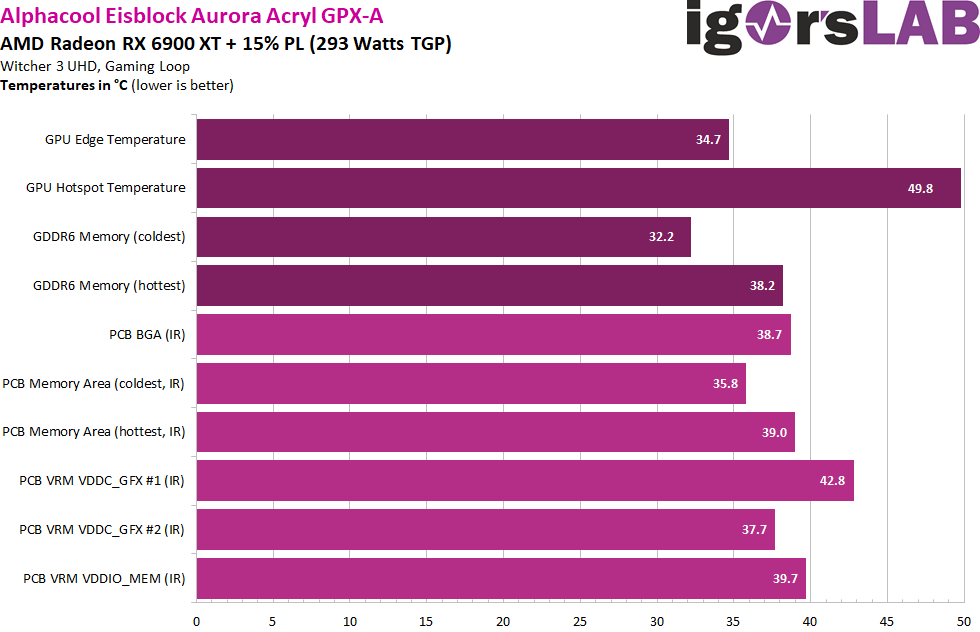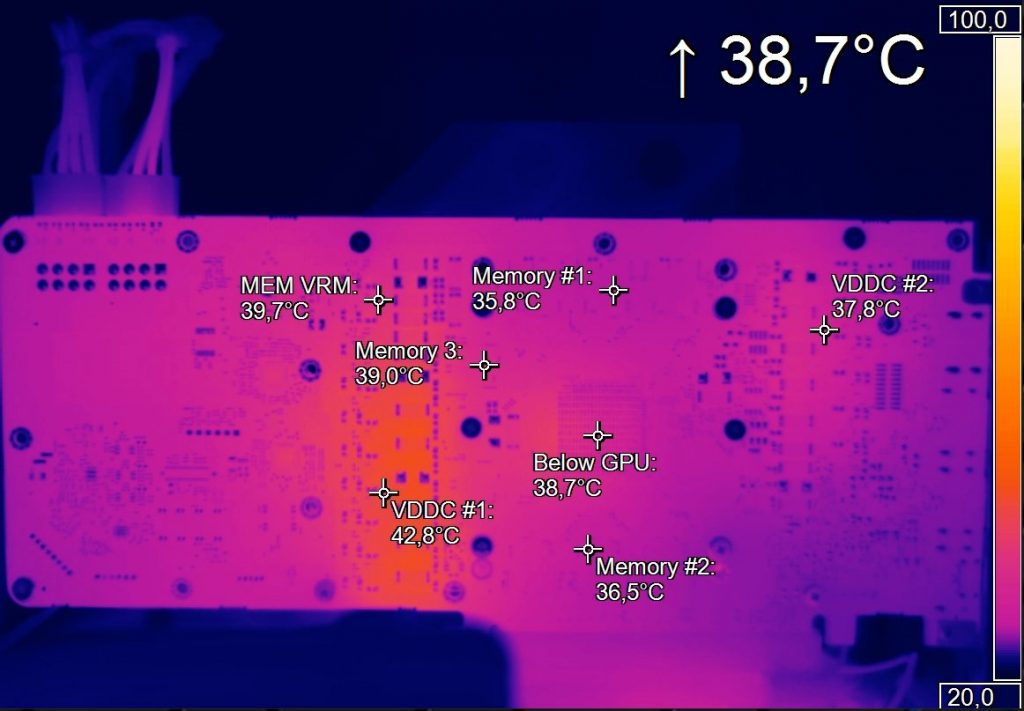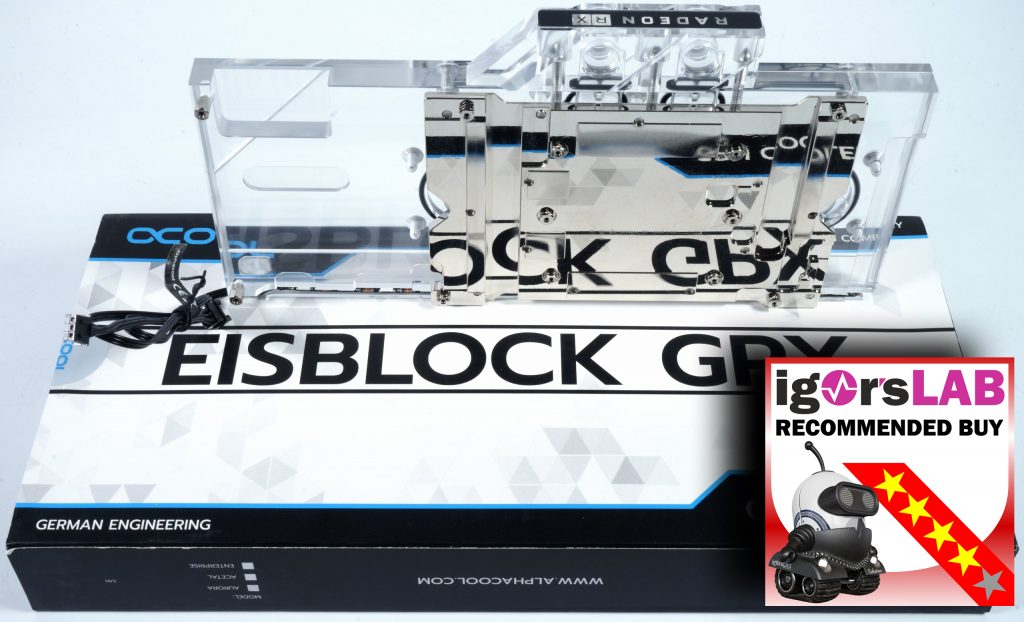Let’s now move on to the measurement, where I rely as always on the central laboratory cooling system with the chiller and another expansion tank. Pure, distilled water is used, which is filtered at regular intervals. The water temperature is kept at a constant 20 °C, which makes it much easier to determine the absolute temperatures and deltas. The internal GPU diode measures from about 19 °C chip temperature reasonably reliably, below that it quickly becomes inaccurate. Room temperature and water temperature are thus also approximately the same, which avoids dangerous condensation.
Temperatures are recorded using an engineering tool for the GPU diode (or hotspot) and the substrate temperature of the GDDR6 (hotspot), as well as using a calibrated, high-resolution industrial camera for infrared measurements. Here the PI640 from Optris with a normal focal length is used. The camera has a 640 x 480 pixel bolometer to detect thermal radiation. For the evaluation I record a radiometric video, which I can later read out as required.
| Test System and Equipment |
|
|---|---|
| Case: |
Open Benchtable |
| Monitor: | Alphacool Eiszeit 2000 Chiller, 20l additional reservoir |
| Power Consumption: |
Oscilloscope-based system: Non-contact direct current measurement on PCIe slot (riser card) Non-contact direct current measurement at the external PCIe power supply Direct voltage measurement at the respective connectors and at the power supply unit 2x Rohde & Schwarz HMO 3054, 500 MHz multichannel oscilloscope with memory function 4x Rohde & Schwarz HZO50, current clamp adapter (1 mA to 30 A, 100 KHz, DC) 4x Rohde & Schwarz HZ355, probe (10:1, 500 MHz) 1x Rohde & Schwarz HMC 8012, HiRes digital multimeter with memory function MCU-based shunt measuring (own build, Powenetics software) NVIDIA PCAT and FrameView 1.1 |
| Thermal Imager: |
1x Optris PI640 Pix Connect Software Type K Class 1 thermal sensors (up to 4 channels) |
| OS: | Windows 10 Pro (all updates, current certified drivers) |
Now the cooler must prove itself! In a slightly regulated circuit with about 100 l/h I let the cooler sweat at 293 watts TGP (about 335 to 340 watts TBP) and Witcher 3 in Ultra-HD for one hour. You have to allow yourself this time, because only after a longer period of time all areas of the board are completely warmed up.
Let’s get to the bar chart, where the slightly darker bars mark the readout results of sensors, while the slightly lighter ones represent the IR measurement results. Let us now come to the individual values. The measurement result for the GPU in this form is ok for now. I read out about 15 degrees as a delta between the water and the GPU, which is hard to classify as a single value at first because there are no comparison values to other water blocks yet.
However, if you take a potent air cooler like the Sapphire RX 6800 XT Nitro+ as a comparison, the 15 degrees should be absolutely ok, as AMD’s 7 nm chips generally get significantly hotter and the distribution of the hotspots is always difficult. Speaking of hotspots, this is where Tjunction comes in. With only 15 degrees as delta to the GPU temperature, you’re clearly better off than with the Sapphire cooler (20 degrees), which should also be an indicator for proper cooling. The read out values for the GDDR6 memory are exemplary, you can really leave it at that.
The values of the IR measurement are a bit higher, because we see here the influence of the voltage supply to the GPU, which warms up the area from the voltage converters to the BGA a bit more. Nevertheless, almost everywhere only temperatures below 40 °C or, with a voltage transformer, just under 43 °C can be measured. This is absolutely useful and exemplary in terms of surface area. The fact that the whole board is only about 20 degrees above the water temperature allows three conclusions: AMD did everything right with the layout of the board, TSMC and the packagers produced an extremely flat package with hardly measurable tolerances (I’ve tested 5 cards that turned out absolutely identical) and the cooler is good. Three insights, one result.
The fact that the cooler can also take more is shown by my OC result, where I was able to dispose of a total of 370 watts without any problems in terms of cooling and was able to get close to the 2.7 GHz mark.
Reading tip: Radeon RX 6900 XT with almost 2.7 GHz in Time Spy – Thanks to water cooling and MorePowerTool
You can read the article on the homepage, or watch the corresponding video:
Summary and conclusion
The Alphacool ice block Aurora Acryl GPX-A in this interpretation for the RX 6800 (XT) or RX 6900 XT deserves a real buying tip simply because of the really excellent low surface temperature. But, Alphacool can’t help it, there must of course be the right cards to go with it. But that in turn is not the problem of Alphacool, which can at least deliver, but of AMD. The storage tank temperatures are very good and there is a lot of air remaining at the top.
The quality of workmanship is good, you can see that Alphacool has made changes not only to the design but also to the production, you can hardly see any tool marks, the fitting accuracy is exemplary and the thread inserts are firm. The price of almost 127 euro including backplate is also okay. The look, on the other hand, is purely a matter of taste and many a person will probably have a general problem with acrylic. Here you simply have to give the eye a certain say in addition to the brain, that’s how fair you have to be.
And what do the other manufacturers do? So far, nobody has sent anything, although requests have not been refused, and I am still surprised that some YouTuber, who proudly presented a demo case of a Slovenian manufacturer for launch, has not published any real performance data until today. If you want a test: please let me know. The test system is still standing.
The test sample was provided by Alphacool free of charge, no influence was exerted on the tests and the results.



































Kommentieren